IT teams have shifted to center court of the organizational communication game. Not only are they still responsible for the infrastructure that allows business to get done, they’re now the architects of digital employee experiences, wielding the power to drive measurable business outcomes through strategic employee technology management. Our 2024 State of the Intranet and Future of Employee Technology report sheds insight into the influence of IT on organizational success through excellent employee experience — and the path forward to more impact through intranet program management.
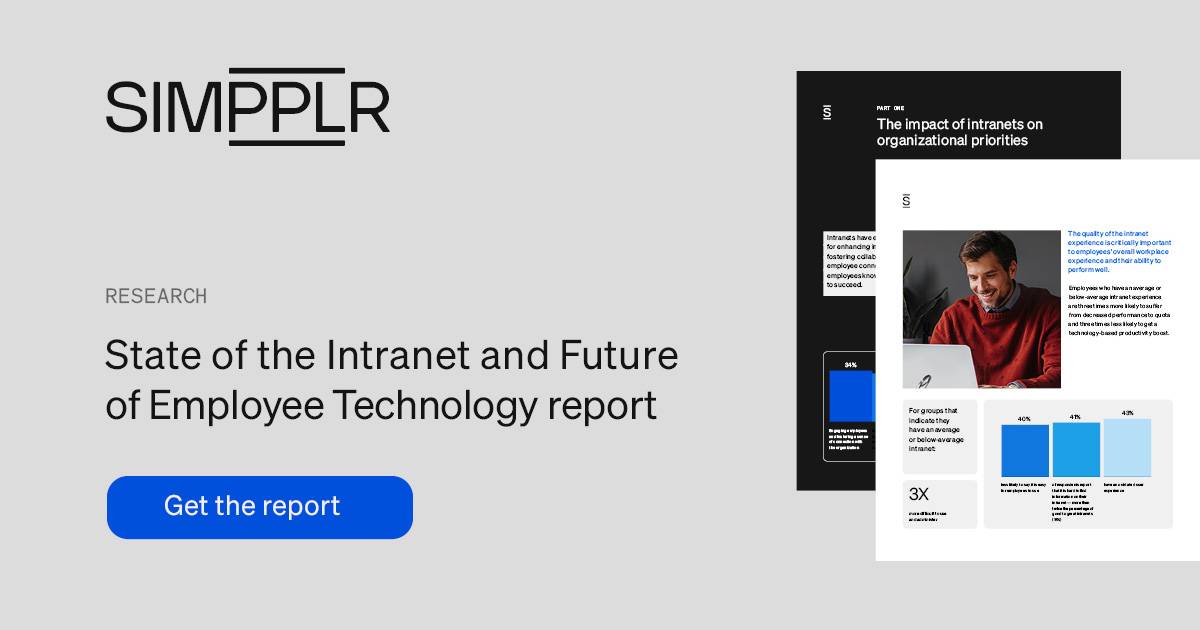
Today’s IT responsibilities are no longer just about managing servers and troubleshooting software. IT teams that guide effective intranet programs and create excellent employee technology experiences drive the bottom-line metrics that matter. Our findings show that 95% of organizations with well-designed intranets report significant productivity gains, 97% see higher levels of employee engagement, and 94% report a positive impact on revenue.
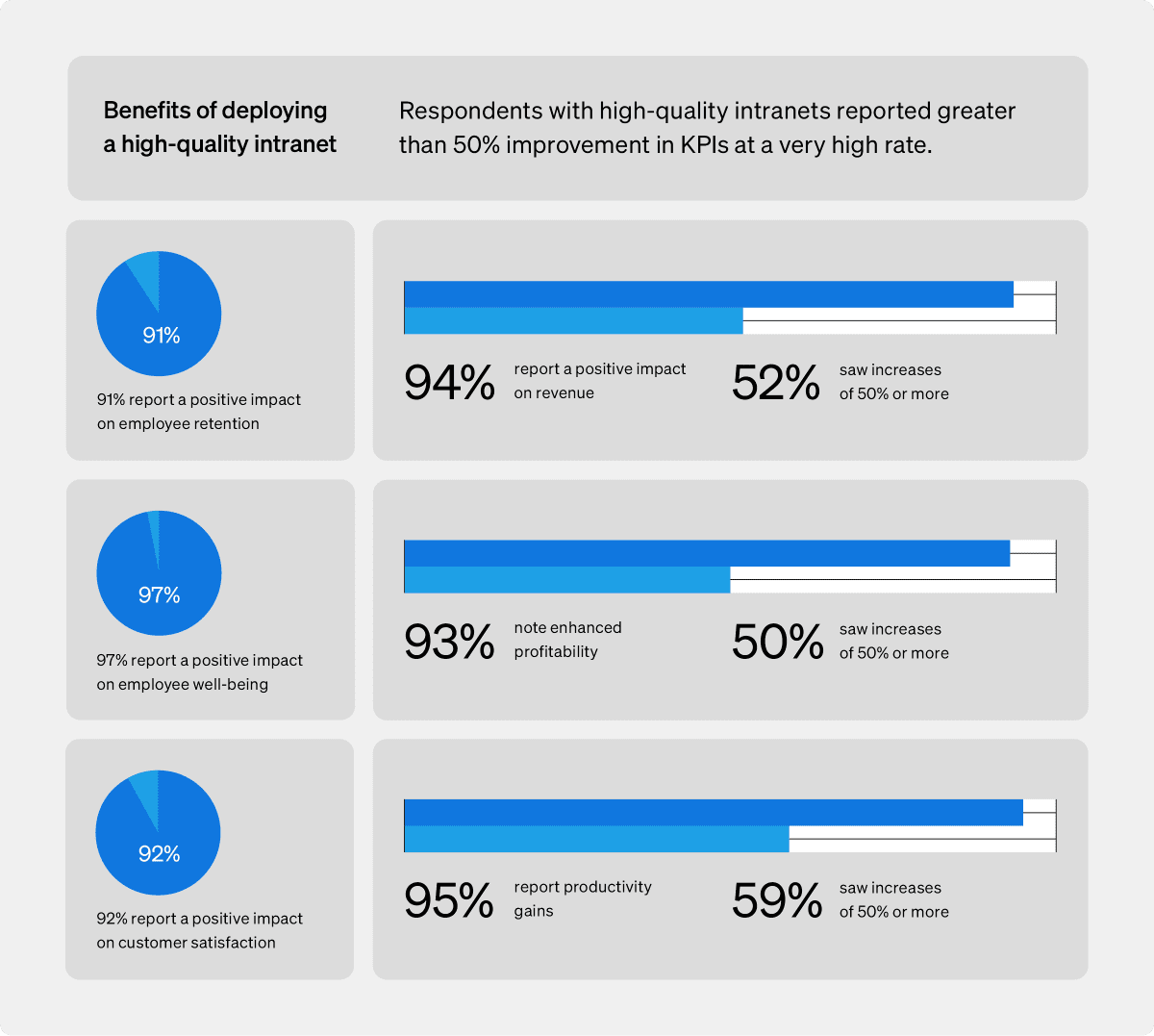
IT teams have expanded responsibilities, but luckily they hold the purse strings, too. Our report reveals that IT departments control 58% of intranet budgets and luckily they are investing in improved functionality and a more unifying experience.
For those organizations still on the fence regarding the importance of intranets, the message is clear: more than one-third of companies plan to implement a new intranet solution within the next 12 months to boost productivity, efficiency and profitability.
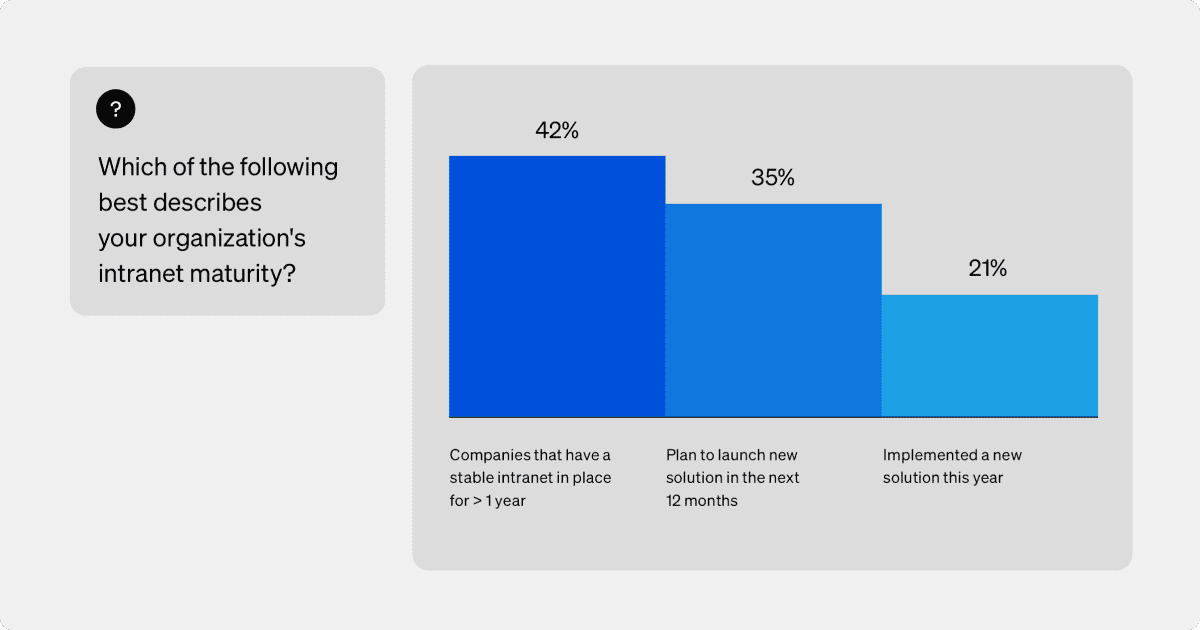
The expertise of IT leaders isn’t just valuable — it’s essential for navigating this digital transformation. There is no doubt that IT teams are well equipped to implement a more modern experience management platform for their organization, and the best and most impactful teams collaborate with their counterparts in Internal Communication and HR departments.
To help IT teams maximize the impact of their intranet programs — whether launching a new intranet platform or optimizing an existing intranet — we’ve identified 10 key strategies based on our comprehensive research.
- 1 Plan for IT resource allocation and reduce dependency
- 2 Prioritize user experience
- 3 Focus on application integration
- 4 Leverage AI-powered capabilities
- 5 Implement robust content management strategies
- 6 Invest in advanced search functionality
- 7 Establish clear governance structures
- 8 Collaborate cross-functionally
- 9 Develop comprehensive adoption strategies
- 10 Regularly assess and measure performance
- 11 Unique challenges for large organizations
- 12 Embrace continuous evolution
Plan for IT resource allocation and reduce dependency
Select a solution that requires minimal IT support post-implementation or face an increased workload. One of the primary challenges facing intranet programs is the heavy reliance on IT resources, cited by 26% of respondents. This taxing dependence can lead to bottlenecks in development and maintenance, potentially resulting in underperforming systems. Additionally, 22% of respondents reported a lack of sufficient IT resources as a significant challenge. When IT teams are not primary managers or power users, intranet projects might not receive the attention and support they need to thrive.
Recommendation: Consider solutions that reduce day-to-day IT involvement while ensuring adequate budget allocation for strategic initiatives. By automating routine tasks and empowering non-technical teams with user-friendly tools, IT can focus on higher-value activities that drive innovation and efficiency.
Prioritize user experience
In our survey, 70% of respondents cite ease of use as the most important characteristic of an effective intranet. User interface and navigation were identified as problem areas by 17% of respondents.
Prioritize user experience when upgrading to a new intranet solution or optimizing your existing platform.
Respondents with “Average” or “Below Average” intranets reported 43% more outdated user experiences and 41% more frustrations in finding information compared to those with more effective intranets. This underscores the importance of selecting technology that is highly personalized, has a consumer-grade interface, and delivers the functionality, resources and access that your employees need.
Recommendation: Regularly gather user feedback and conduct usability testing to ensure the platform meets employee needs and expectations. Remember, no matter how sophisticated the backend, if end users are not satisfied, your intranet program is less likely to succeed.
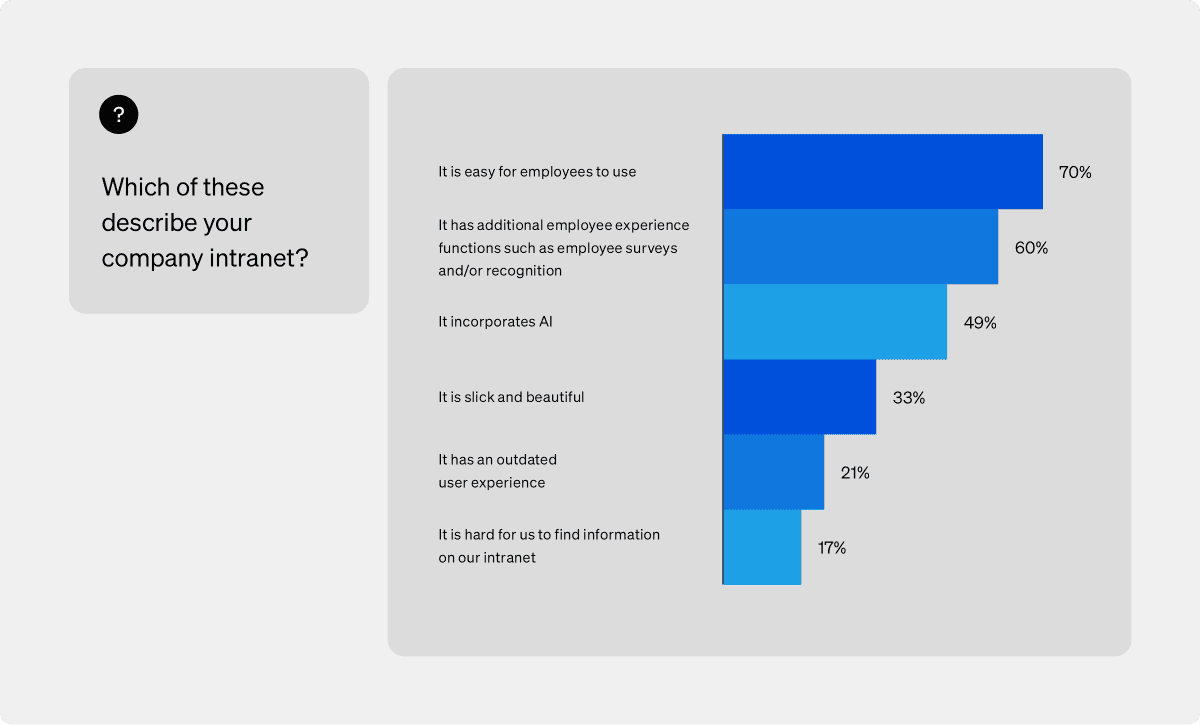
Focus on application integration
Seamless integration with key business applications significantly enhances an intranet’s value and usability. Our data shows that document management tools (51%), IT ticketing systems (51%), and social/collaboration tools (48%) are among the most integrated tools and systems. However, there’s room for improvement, especially with AI assistants, which only 32% of respondents report having integrated.

Lack of workplace app integrations is another indication of intranet failure, with 21% of survey participants listing lack of integrations as a significant challenge in an environment with an overwhelming number of employee systems. This often leads to information silos, reduced efficiency, and a disjointed user experience.
Recommendation: When selecting or upgrading intranet platforms, prioritize robust integration capabilities to create a cohesive digital workplace ecosystem. In our experience, IT managers can often obtain best-in-class integration more easily with third-party SaaS solutions, such as Simpplr, rather than building in-house. This approach typically provides access to feature-rich, fully integrated and regularly updated platforms that are on pace with rapidly evolving technology and user expectations.
Leverage AI-powered capabilities
The adoption of AI presents both opportunities and challenges for intranet program leaders. While 18% of respondents reported that their intranet lacks proper AI functionality, 87% agreed that AI is or will become an important resource. However, only 75% reported that AI tools and resources are widely available in their workplace — indicating a gap between awareness and implementation.
Recommendation: Explore and implement AI-driven capabilities that enhance personalization, automate workflows, and improve overall efficiency. For example, AI can support content management by automatically categorizing and tagging content, making it easier to organize and retrieve information.
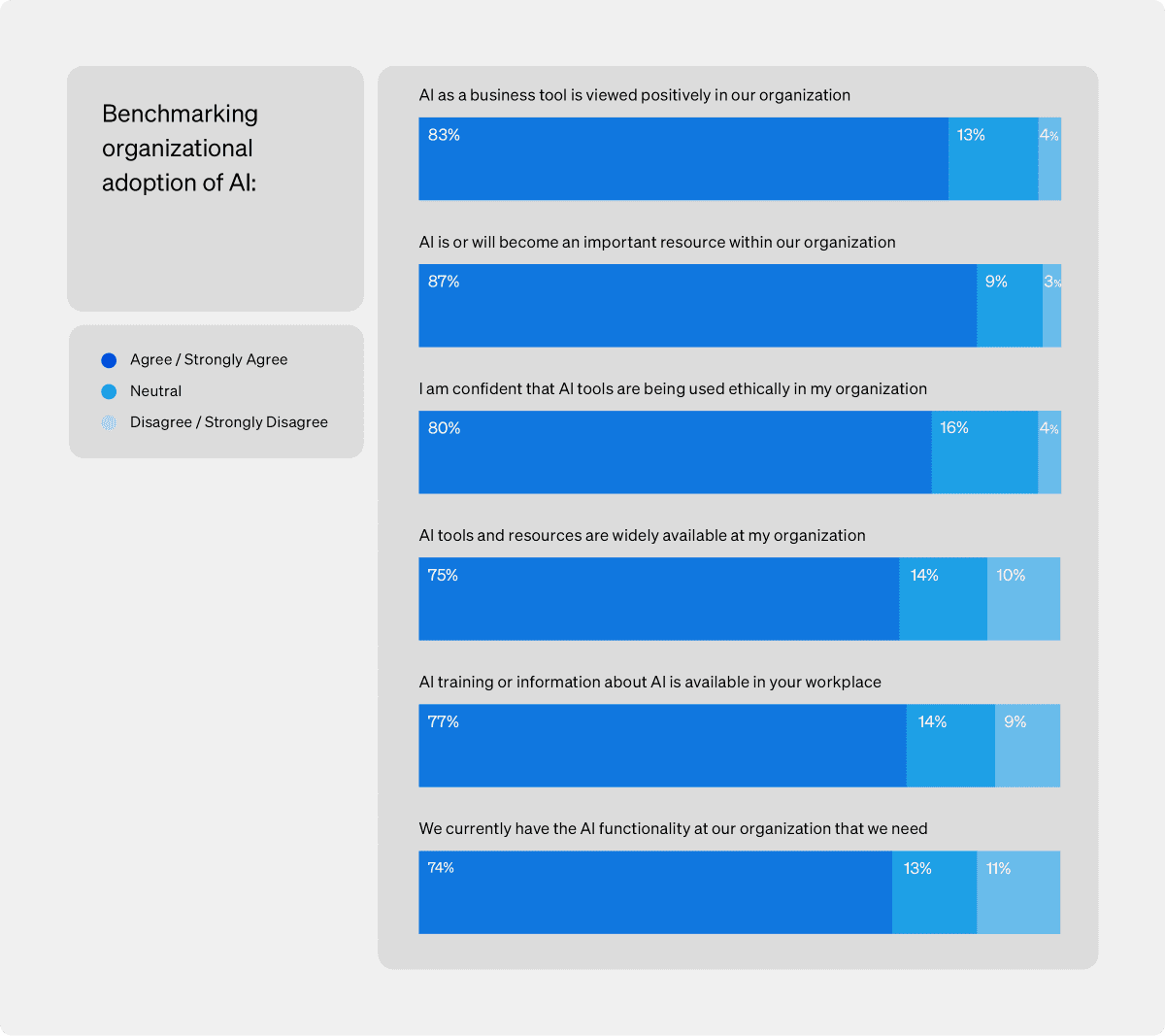
Implement robust content management strategies
Content quality plays a crucial role in determining user experience, with 35% of respondents citing stale or hard-to-find content as a key challenge. In addition, our survey found that content and search quality are the most important KPIs for respondents, with 61% ranking them as critical to intranet success.
Intranets that provide timely and relevant content build trust and see higher user adoption rates — creating a positive feedback loop of engagement and usage.
Recommendation: Audit your content frequently, establish clear ownership of content areas, and utilize automated processes such as AI-powered content moderation for identifying and updating outdated information.
Invest in advanced search functionality
A staggering 81% of respondents reported lack of AI integrated enterprise-level search. Only 19% said their intranet includes accurate search functionality that leverages AI for personalized, precise results. Meanwhile, 9% stated that their intranet’s search functionality does not cover all employee content and knowledge sources, forcing employees to look elsewhere for information.
This limitation can severely impact productivity and user satisfaction.
Recommendation: Invest in advanced search capabilities, including AI-powered solutions that provide more accurate and comprehensive results across all integrated systems. Your organization will benefit from stronger overall intranet performance and more productive employees. The better the search, the better the experience.
Establish clear governance structures
Who’s in charge of what? Unclear intranet ownership and governance were cited as challenges by 11% of respondents. Well-defined governance practices significantly enhance user experience and administration satisfaction — so it’s critical to establish clear governance structures and processes to ensure effective intranet management.
Without clear responsibility and direction, intranets can quickly become disorganized and ineffective.
Most IT teams understand this, as 75% of respondents in our survey reported well-documented intranet usage guidelines, and 56% have processes for auditing and archiving content.
Recommendation: Work closely with key stakeholders to develop and enforce these governance practices, ensuring that the intranet remains a valuable tool for all employees.
Collaborate cross-functionally
Our survey data reveals that IT departments predominantly control intranet operations, with 58% of intranet budgets held by IT. While IT expertise is crucial for technical aspects of intranet deployment and maintenance, the effectiveness of an intranet as an employee communication and collaboration solution increases with involvement from departments like Internal Communication and Human Resources. By working together, these teams can create a more holistic and impactful employee technology experience.
An IT-centric approach might have significant implications for the focus and direction of intranet development, potentially emphasizing technical capabilities over communication or employee engagement aspects.
Recommendation: Foster cross-functional collaboration to ensure that the intranet not only meets technical standards but also aligns with broader organizational communication and engagement goals. Adhere to intranet best practices to raise employee engagement.
Develop comprehensive adoption strategies
Our survey found that employee engagement and intranet usage remain persistent challenges, with 13% of respondents citing low usage and engagement as a problem. Additionally, 11% reported that some departments or locations struggle to adopt the intranet, suggesting potential issues with meeting diverse organizational needs.
Recommendation: To increase usage, make sure you offer sufficient intranet training and support. Consider partnering with Internal Communication teams to share helpful information and resources in the channels that employees use the most, and lean into strategic change management — emphasizing the value employees will derive from using the intranet. Boost engagement with personalized content, AI assistance, and integrated employee recognition and rewards.
Regularly assess and measure performance
What’s measured gets improved. It’s critical to consistently track and analyze key performance indicators (KPIs) to drive continuous improvement. Our survey found that content and search quality (61%), intranet engagement (57%), and operational efficiency (52%) are the most important KPIs for respondents.
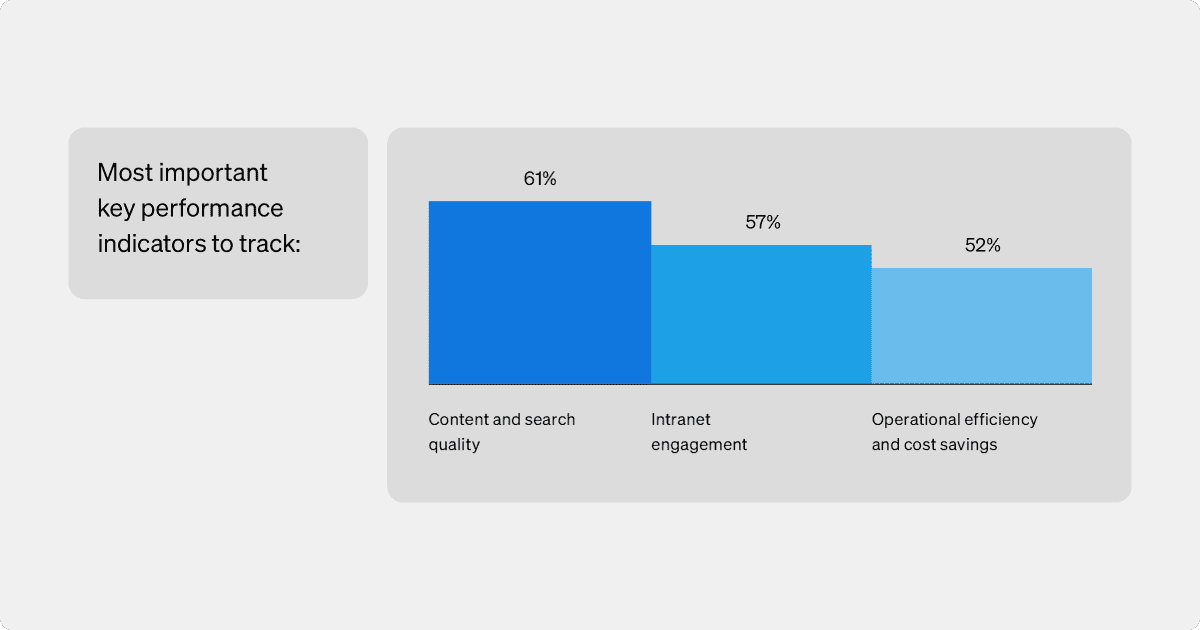
Interestingly, larger companies (with 10,001+ employees) are less likely to track intranet adoption rates (33% vs. 41% overall) and gather frontline manager feedback (33% vs. 37%). This trend could be directly linked to the fact that larger organizations are more likely to have built their own intranets, which might lack the sophisticated analytics and feedback tools available in the best commercial solutions.
Recommendation: Adopt a data-driven approach. Focus on tracking content and searchquality, intranet engagement numbers, and operational efficiency and cost savings. When upgrading your intranet platform, look for a solution with robust analytics and insights.
Unique challenges for large organizations
As mentioned above, larger organizations — particularly those with 10,000+ employees — face unique challenges that forward-looking IT teams can help them overcome. They are more likely to have built their own platforms (24% compared to 12% overall) but are less likely to rate their intranets as “Great” (32% vs. 38% overall). These organizations also report lower ease of use (54% vs. 67% overall) and higher difficulty in finding information (29% vs. 20% overall).
Total cost of ownership (TCO) is a pivotal metric in evaluating the value of an intranet — especially in larger organizations.
The direct and indirect costs of a stale intranet can significantly impact employee productivity, engagement, and ultimately, profitability.
Despite the prevalence of custom-built solutions in larger companies, these same organizations often struggle with maintaining modern, user-friendly systems. This could be due to the complexity of their operations, the challenges of implementing changes across a large workforce, or the inertia of legacy systems.
Embrace continuous evolution
As intranets continue to evolve, it’s vital to focus on providing user-friendly interfaces, quality content that’s easy to find, and advanced features like personalization and AI assistance to drive adoption and engagement.
- Maintain your focus on intranet quality and the upstream drivers of user experience, as they significantly impact overall employee satisfaction and performance.
- Continuously update and evolve your intranet system to keep pace with rapidly changing user expectations and technological advancements, particularly by incorporating AI-supported functionality.
- Evaluate AI readiness and invest in the right functionality for the right groups of employees, enhancing search capabilities and ease of use.
By implementing these strategies, IT teams can create more impactful intranet programs that drive measurable business outcomes and enhance the overall employee experience. As the digital workplace continues to evolve, the role of the intranet in facilitating communication, collaboration and productivity will only grow in importance.
How Simpplr can help
A trusted partner to more than 1,000 leading brands, Simpplr drives employee engagement and productivity through our comprehensive employee experience management (EXM) platform. Leveraging AI, Simpplr delivers personalized, frictionless digital experiences, empowering employees to perform their best work from anywhere.
From enterprise search to agentic workflows — we do it all securely and at scale.
- AI-first architecture: Extensive AI capabilities across the platform power every aspect of the employee experience, from search to automated issue resolution.
- Secure and proven in the enterprise: Delivering over 2 billion digital experiences annually for 1,000+ companies with a trusted, 508-compliant platform supporting 35+ languages.
- Easy on IT: A low-code, no-code platform with auto-governance makes it easy to quickly consolidate EX applications and centralize knowledge without burdening IT.
Request a demo today to learn more.















